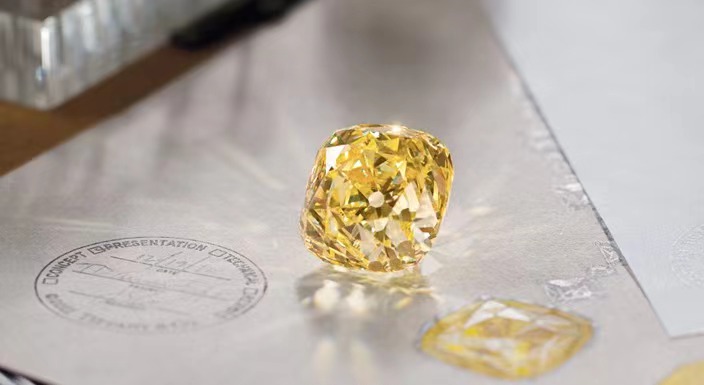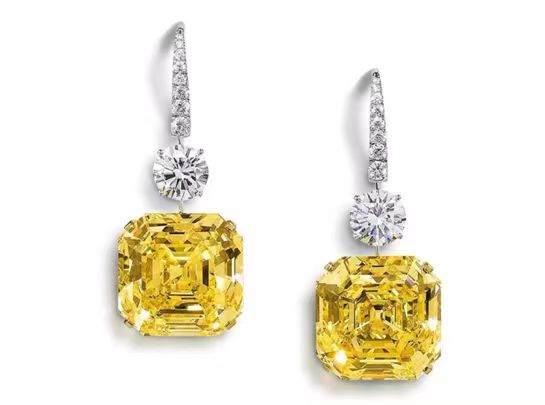Yellow diamond, also known as yellow diamond, is a kind of coloured diamond, which refers to the pure yellow or golden coloured diamond in the diamond. Among the colourful diamonds, yellow is the second most common colour. But yellow diamonds that reach the gorgeous level are very rare. White diamonds with colour difference cannot be called yellow diamonds. The international authoritative classification agency for the colour of yellow diamonds is GIA of the American Jewellery Academy, which divides the colour of yellow diamonds from light to dark into six levels.
Some natural yellow diamonds are also known as "Canary Yellow Diamonds" because of their bright colours and distinctive characteristics, so yellow diamonds are sometimes marketed under the name of Canary. Although this statement is not an appropriate grade name, it is often used in the industry as a term for describing high-quality yellow diamonds.
After the white light of visible light enters the diamond, the diamond absorbs certain bands or wavelengths in the spectrum and returns or transmits it to the eyes of the observer. This project is called selective absorption. The colour of all substances is determined by this, and so are diamonds.
The colour of the observer's eyes, that is, the colour of the object, is a combination of many unabsorbed light waves. If only a few or no light waves are absorbed, all the light waves in the spectrum return, and the object is colourless or white; if all the spectra are absorbed, the object is black, and there are infinite possibilities between the two.
The first is the existence of impurities, that is, atoms other than carbon atoms.
The second is structural defects, such as the lack of carbon atoms in the lattice or the distortion of the lattice.
First of all, why is it a nitrogen atom? This is because the carbon atoms in the cubic structure of nitrogen atoms and diamond are about the same size and are easy to distribute in the structure, and others such as Cr and Fe are too large to enter the lattice.
When nitrogen atoms replace some carbon atoms in diamond crystals (100 of every million carbon atoms are replaced), the N3 centre, that is, the N3 colour core, is, 3 nitrogen atoms surround a hole. There is obvious absorption (called N3 absorption) at 415nm from visible light blue to purple. The centre of N3 can absorb the spectrum from the blue to the end of ultraviolet, and the diamond will produce yellow. The more N3 centres, the yellow the diamond will be. This is why the colour of the yellow diamond is different.
The distortion without impurities on the lattice will also form a colour centre. For example, the octahedral direction occasionally forms a stress or sliding surface during the crystal growth process. When light passes through, it may cause partial absorption, reducing the transparency of the diamond and bringing smoke gray or brown.
The brown colour of yellow diamonds is mostly related to nitrogen, while a few brown diamonds are found to be caused by hydrogen-related lattice defects.

Myth 1. As long as it is a yellow diamond, it is a yellow diamond: Except for a very small number of Type IIa diamonds, almost all white diamonds contain a slight nitrogen element. Generally, white diamonds after H level can see a slight yellow tone. The lower the level, the more obvious the yellow tone. This kind of diamond with a yellow tone is not It's a yellow diamond, and the more yellow it is, the lower the price.
Misunderstanding 2. The colour of the yellow diamond will fade: the yellow diamond will not fade with wearing, and its colour is produced by the effect of optics! Diamonds appear yellow because nitrogen atoms replace some carbon atoms in diamond crystals during their formation and begin to absorb blue-purple light. Its colour is naturally formed and will not change due to wearing.
Myth 3. Yellow diamonds are all natural: yellow diamonds can be artificially synthesised or artificially made by irradiation and colour modification.

Most of the diamonds cultivated by the HTHP method are yellow series, which is because the diamonds synthesised by this method cannot form the N3 colour heart of natural diamonds because they grow too fast. The colour of the yellow or orange diamond cultivated by HPHT is due to the introduction of isolated nitrogen in the growth process, and the excess of Ib diamonds. The electrons lead to the absorption of blue light and the formation of yellow tones. With the increase of the content of lone nitrogen, the yellow colour of diamonds will become brighter and brighter. Due to insufficient control over nitrogen elements, the probability of forming a bright yellow colour is very low.
Most of the CVD cultivated diamonds are lla-type, and the probability of forming bright yellow is extremely low, and most of the yellow-bred diamonds that appear are attributed to accidental or intentional intubation of nitrogen.
